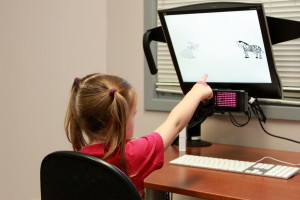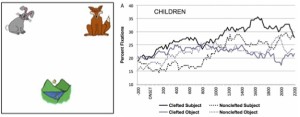
CHILD RESEARCH
We are currently conducting research with children ages 3-6 years old. The majority of our child studies are run by research assistants and take place at preschools in the Edmonton area. Children at preschools only take part in the experiments if we have received written consent from their primary guardians.
If you are interested in having your child participate in one of our studies, click here for more information.
EYE-TRACKING STUDIES

All of our studies with children use non-invasive eye-tracking equipment and involve fun, interactive activities. Children sit in a chair with a sticker on their forehead and watch images or videos on a screen. Our eye-tracking camera only records the pupil and where it looks on the screen, so there are no saved images of the children’s faces. The purpose of our research is to learn about how young children are different from adults in their understanding of language and to identify the stages of development that children pass through.
If you would like to learn more about eye-tracking, click here.
RECENT STUDY: Children’s Comprehension of Visually Situated Discourse Reference

How do children understand reference given the time constraints of normal conversation? We use eye-tracking to investigate how monolingual and bilingual children process spoken discourse in the visual world and how grammar and information structure interact with visual-referential context, cues to shared attention, and emotional information.
STORYBOOK PILOT STUDY
We are currently testing an exciting new way of conducting eye-tracking experiments with child participants! Rather than playing games, a primary guardian reads a story to the child. The story is complete with accompanying art like a regular children’s storybook and it is written specifically to determine how children process different aspects of language. The story could be in book form or on an iPad. While the child is being read to, he/she will wear eye-tracking glasses. These glasses will keep track of where the child is looking on the page and send the data to a small device, so there will be no need for a big set up of equipment. We are excited about this new style of experiment as it will put the child in a much more natural environment when being tested.
If you would like to request the results of a study your child previously participated in, click here.
